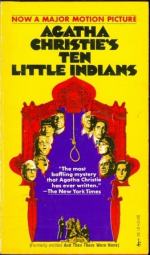|
|
And Then There Were None Manuscript
The final chapter is an extended confession, in which Wargrave explains why he murdered everyone, and how. "From an early age I knew very strongly the lust to kill..." Chapter 18, pg. 261 These feelings were mixed with a strong sense of the importance of law and order, so he became a judge. His love of detective fiction also led him to devise clever ways of killing people. He loved punishing the guilty, especially sentencing them to death, but he hated the idea of an innocent person being punished. Eventually, he realized that just sentencing people to death wasn't good enough - he wanted to murder someone himself. After finding out that he had cancer, he began planning the perfect crime he'd always dreamt of. A conversation with a doctor, who happened to be Jennifer Brady's doctor, suggested to Wargrave the perfect scenario - he could mix his urges, by murdering the guilty that no court could ever punish.
He found Armstrong when a Nun mentioned to him the case of a drunken doctor who killed someone on the table. He was able to find the rest of his victims by just bringing up the subject of justice in casual conversation. It seemed that everyone had a story to tell about some person who had escaped justice. Vera was the last one that he'd discovered, while on a Ocean voyage. He met a drunken Hugo Hamilton, who was miserable. Hugo told Wargrave the story of how a Woman had murdered his Nephew out of a misguided love for him. No one had suspected her, but the second Hugo saw her again, he could tell from her eyes that she'd murdered Cyril . Wargrave needed a tenth victim to fit the rhyme, since he didn't consider himself guilty of anything. He found Morris, a criminal who had gotten a friend's daughter addicted to drugs. After finding out that his cancer was incurable, he used Morris to buy Indian Island and began setting his plan into motion, luring everyone to the Island.
Wargrave killed Morris by giving him a poisoned capsule to take for indigestion. Morris had never suspected anything. Wargrave had determined that he was going to try to kill everyone based on order of guilt, the least guilty first. He'd watched everyone's faces while the accusations were being read, and based on his years of experience, was sure that they were all guilty. He killed Marston by slipping Cyanide into the glass while everyone was distracted, then put an overdose of sleeping medicine into the Brandy Rogers brought up to his wife. The next day, he waited until everyone was away from the terrace, snuck up and killed Macarthur, then rushed back to the terrace before anyone noticed him missing. Wargrave then recruited Armstrong to help him 'find the killer'. Armstrong was sure Lombard was the killer, and Wargrave suggested they could trap him. Wargrave woke up early the next day, killed Rogers, stole the key, and then went back to bed. After everyone went downstairs to look for Rogers, he stole Lombard's gun. At Breakfast, Wargrave put the last of his sleeping medicine into Emily's coffee, and once she was asleep and everyone left the room, he snuck back in and injected her with the last of his Cyanide.
Wargrave hid the revolver inside the pantry, inside a tin of crackers. After hiding the gun inside, he put some tape on it, making it look like the tin had never been opened That night, he and Armstrong put their plan into effect. He planted the seaweed in Vera's room, and then, when everyone ran off, he put on his costume and dabbed some red paint onto his forehead. When everyone returned to the candlelit drawing room, only Armstrong examined the body. No one else got close enough to realize he wasn't dead. Later that night, he lured Armstrong out to the cliffs, and then pushed him off. He then returned to the house and made enough noise so that Blore and Lombard would notice that Armstrong was missing. After that, he hid back in his bed. When they next searched the house, all they dead was lift the sheet off his face to confirm that the right body was in the right bed. While everyone searched outside, Wargrave put the revolver back in Lombard's room.
Wargrave watched the three remaining people, wondering who would kill who. When Blore approached the house, he pushed the clock from the window. Wargrave then watched Lombard and Vera. He was glad Vera shot Lombard, because he knew there was little chance of Lombard ever killing himself. Vera on the other hand, was just unbalanced enough. Wargrave then wrote his confession and sealed it up in a bottle, and threw it off the island. His hope was that he'd committed an unsolvable crime, but he couldn't resist letting someone in on his genius by writing out a confession, albeit one that might never be found. Wargrave feels that the crime is unsolvable, except for three clues. 1 - He's the only innocent person on the island. 2 - The red herring line in the rhyme suggests some kind of a trick involving the doctor. 3 - The red hole in Wargrave's forehead is the mark of Cain. Wargrave then attached a rubber band to the gun and his glasses, so that he could shoot himself in the head while lying in bed, and the gun would be thrown across the room after he shot himself in the forehead, making it look as if the gun had been dropped there by someone long after Wargrave's murder.
Topic Tracking: Guilt and Responsibility 17
Topic Tracking: Trust and Suspicion 17



